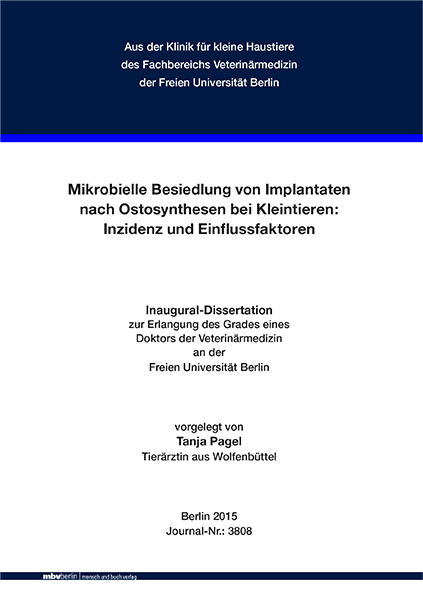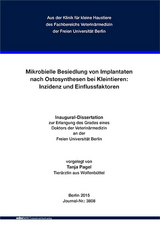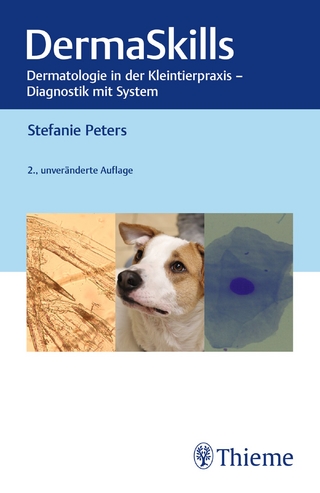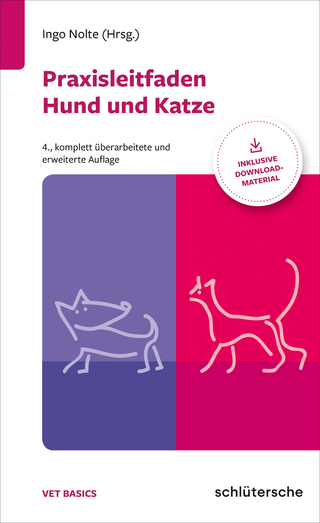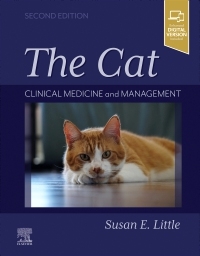Mikrobielle Besiedlung von Implantaten nach Ostosynthesen bei Kleintieren: Inzidenz und Einflussfaktoren
Seiten
2015
|
1. Aufl.
Mensch & Buch (Verlag)
978-3-86387-650-0 (ISBN)
Mensch & Buch (Verlag)
978-3-86387-650-0 (ISBN)
- Keine Verlagsinformationen verfügbar
- Artikel merken
- Microbial colonisation of explants after osteosynthesis in small animals: incidence and influencing factors -
All in all implant associated infection rarely occurs in orthopaedics. Nevertheless it is a serious complication that may result in decelerated fracture healing, loosened implants, function loss and osteomyelitis. The pathogenesis of numerous infections in surgical orthopaedics is influenced by microorganisms in biofilm. Biofilm bacteria make up 60 % of entire nosocomial infections. For the first time ever, the survey here presents analyses of the incidence of infection of explants and associated complications as well as the spectrum of pathogens, to find possible risk factors regarding plate osteosynthesis.
The study includes 51 dogs and 14 cats of differents breeds having had plate osteosynthesis with screws which were removed between February 2010 and March 2013 and Microbiologic samples were taken. In 49,3 % of those explants (n = 35) microorganisms were detected. Staphylococcus ssp. was detected most frequently.
The healing process was uncomplicated in 26 of 68 operations examined although 12 explants of this group showed microbiological agents. In 21 out of 42 patients having complications (50%) microorganisms were detected. Likelihood of infection increases by ascending age and weight.
Infection risk was influenced by body weight and age. Sex was not a relevant parameter for risk of infection.
Areas distales of the elbow (n = 18/21, 85,7%) and knee joint (n = 10/14, 71,4 % ) were infected more often compared to proximal locations.
Explants of trauma patients suffering from lung lesions were significantly more often infected. (p = 0,028). Additional lesions such as superficial wounds and fractures had no significant influence on the manifestion of an infection of the explant.
With 59, 5% infections of non-contact-plates occured more frequently compared to infections of dynamic-compression-plates (39,3%) and t-plates (33,3%). 38,5% of thin 2 to 2,7 mm explants were infected as well as 62,5% of thick 3,5 to 4,5 mm explants.
There is a percental higher risk of infection of the explant in surgery performed by an experienced surgeon (52%) in comparison to an inexperienced surgeon (42,9%). The risk of infection increases by the number of persons attending. One person assisting led to a 42,9% risk of infection, as with two it made 66,7%. 14 out of 16 operations with three assistants attending were performed by an experienced surgeon.
Risk of infection decreased with duration of hospitalization. Time in situ has no significant influence on the risk of infection.
In 36 out of 68 cases no abnormality was detected radiographically at time of explantation. In 32 cases the following findings were diagnosed most often: osteolysis (n =20, 29,4%), demineralisation of the bone in plate zone (n = 9, 13,2%), implant break (n = 2, 2,9%), loosened screws (n = 6, 8,8 %), deflection of plates (n = 2, 2,9%) and sequestration (n = 2, 2,9%). 60% of the explants of patients showing visible osteolysis were infected. Just as well in 55,6, % (n = 5) of the explants of those patients dealing with evident bone deterioration, 50% with loosend screws and 28,6 % (n=2) with implant break.
73,3 % of animals showing dysfunctional mobility at time of explantation, with limb in a misalignment or swollen had infected explants. In 5 patients (n = 51 9,8%) an osteomyelitis was detected clincially and radiographically at time of explantation.
The survey hardly determined statistically significant factors but revealed those which by trend promote infections. Almost 50% of the entire explants were colonised with microorganisms, although just 7,4% of the patients fell ill.
Following clincial trails should establish defined sampling plans for microbial analysis (at time of opening the operation field, before wound closure and explantation) as well as increase the number of patients participating to substantiate the relevance of results. Die implantatassoziierte Infektion ist in der Orthopädie bei Mensch und Kleintier insgesamt selten, aber für einen Patienten eine gravierende Komplikation, weil die Frakturheilung verzögert abläuft, sich Implantate lockern, ein Funktionsverlust entstehen und der Infekt in einer Osteomyelitis enden kann. Die Pathogenese zahlreicher Infektionen der chirurgischen Orthopädie wird von Mikroorganismen in Biofilmen beeinflußt. Die Biofilmbakterien machen etwa 60% aller nosokomialen Infektionen aus. In der vorliegenden Studie wurde erstmals die Infektionsinzidenz an den Explantaten und die damit assoziierten Komplikationen und das Erregerspektrum analysiert, um daraus etwaige Einflussfaktoren der Plattenosteosynthese zu finden.
Studiengut waren 51 Hunde und 14 Katzen verschiedener Rassen, denen im Zeitraum 02/2010 bis 03/2013 ein Plattenimplantat mit Schrauben entnommen und mikrobiologisch untersucht wurde. Auf 49,3% (n=35) der Explantate konnten Mikroorganismen nachgewiesen werden. Staphylokokkus ssp. war der häufigste Infektionserreger.
Nach 26 der 68 Operationen verlief die Heilung komplikationslos obwohl bei 12 der 26 Explantate mikrobiologisch Erreger nachgewiesen wurden. Bei den 42 Patienten mit einer Komplikation konnten bei 21 (50%) Mikroorganismen aufgespürt werden.
Körpergewicht und Alter sind Einflussfaktoren hinsichtlich einer Infektion. Das Geschlecht der Patienten war kein relevanter Parameter für ein erhöhtes Infektionsrisiko. Je älter und schwerer die Tiere waren, desto höher war die Wahrscheinlichkeit einer Infektion.
Der Bereich distal des Ellenbogens (n=18/21, 85,7 %) und distal des Kniegelenkes (n=10/14, 71,4%) war wesentlich häufiger infiziert als die proximalen Abschnitte.
Die Explantate von Traumapatienten mit Lungenläsionen waren signifikant höher infiziert (p=0,028). Weitere zusätzliche Läsionen wie Hautwunden und Frakturen hatten keinen signifikanten Einfluss darauf ob eine Infektion am Explantat vorlag oder nicht.
Das Non-Contact-Explantat war mit 59,5% häufiger infiziert als das der Dynamischen-Kompressions-Platten mit 39,3% oder der T-Plättchen mit 33,3%. Dünne 2-2,7mm Explantate waren zu 38,5% und dicke 3,5-4,5mm zu 62,5% infiziert.
Prozentual ist das Infektionsrisiko eines Explantates mit 52% bei einem erfahrenen Chirurgen höher als bei einem unerfahrenen mit 42,9%. Das Infektionsrisiko steigt mit der Zahl der Personen im Operationsraum. Bei einer assistierenden Person betrug es 42,9% während es bei dreien 66,7% ausmachte. 14 von 16 Operationen mit drei Assistenten wurden von einem erfahrenen Operateur geleitet.
Die Infektionsgefährdung nahm mit der Dauer des stationären Aufenthaltes ab. Die Liegedauer der Implantate beeinflusste das Infektionsrisiko nicht signifikant.
Röntgenologisch war in 36 von 68 Fällen bei Explantation kein besonderer Befund zu vermerken. In 32 Fällen wurden am häufigsten eine Osteolyse (n=20, 29,4%) und Demineralisierung des Knochens im Plattenbereich (n=9, 13,2%), vor Implantatbrüchen (n=7, 10,3%), gelockerten Schrauben (n=6, 8,8%), Plattenbiegung (n=2, 2,9%) und Sequestrierung (n=2, 2,9%) diagnostiziert. Infiziert waren die Explantate bei 60% (n=12) der Patienten mit sichtbarer Osteolyse, bei 55,6% (n=5) mit ersichtlichem Knochenabbau, bei der Hälfte mit gelockerten Schrauben sowie bei 28,6% (n=2) mit einem Implantatbruch. Beide Sequestrierungen und eines der gebogenen Explantate waren infiziert.
Tiere, die bei Explantation im Bewegungsablauf funktionsgestört waren, bei denen die Gliedmaße in Fehlstellung geheilt oder geschwollen war, wiesen zu 73,3% einen Explantatinfekt auf. 5 (N=51, 9,8%) Patienten hatten bei Explantation klinisch und röntgenologisch eine Osteomyelitis.
Auch wenn bei der Analyse der Faktoren kaum Signifikanzen festgestellt werden konnten, so waren doch einige die Infektion tendenziell begünstigend. Nahezu 50% aller Explantate waren von Mikroorganismen besiedelt, obwohl nur 7,4% der Patienten erkrankt waren. In weiteren Studien sollte eine Probengewinnung für mikrobiologische Untersuchungen bei Öffnung des Operationsgebietes, vor dem Wundverschluss und bei Explantation routinemäßig erfolgen, um die Relevanz der Ergebnisse an einem größeren Patientengut weiter zu hinterlegen.
All in all implant associated infection rarely occurs in orthopaedics. Nevertheless it is a serious complication that may result in decelerated fracture healing, loosened implants, function loss and osteomyelitis. The pathogenesis of numerous infections in surgical orthopaedics is influenced by microorganisms in biofilm. Biofilm bacteria make up 60 % of entire nosocomial infections. For the first time ever, the survey here presents analyses of the incidence of infection of explants and associated complications as well as the spectrum of pathogens, to find possible risk factors regarding plate osteosynthesis.
The study includes 51 dogs and 14 cats of differents breeds having had plate osteosynthesis with screws which were removed between February 2010 and March 2013 and Microbiologic samples were taken. In 49,3 % of those explants (n = 35) microorganisms were detected. Staphylococcus ssp. was detected most frequently.
The healing process was uncomplicated in 26 of 68 operations examined although 12 explants of this group showed microbiological agents. In 21 out of 42 patients having complications (50%) microorganisms were detected. Likelihood of infection increases by ascending age and weight.
Infection risk was influenced by body weight and age. Sex was not a relevant parameter for risk of infection.
Areas distales of the elbow (n = 18/21, 85,7%) and knee joint (n = 10/14, 71,4 % ) were infected more often compared to proximal locations.
Explants of trauma patients suffering from lung lesions were significantly more often infected. (p = 0,028). Additional lesions such as superficial wounds and fractures had no significant influence on the manifestion of an infection of the explant.
With 59, 5% infections of non-contact-plates occured more frequently compared to infections of dynamic-compression-plates (39,3%) and t-plates (33,3%). 38,5% of thin 2 to 2,7 mm explants were infected as well as 62,5% of thick 3,5 to 4,5 mm explants.
There is a percental higher risk of infection of the explant in surgery performed by an experienced surgeon (52%) in comparison to an inexperienced surgeon (42,9%). The risk of infection increases by the number of persons attending. One person assisting led to a 42,9% risk of infection, as with two it made 66,7%. 14 out of 16 operations with three assistants attending were performed by an experienced surgeon.
Risk of infection decreased with duration of hospitalization. Time in situ has no significant influence on the risk of infection.
In 36 out of 68 cases no abnormality was detected radiographically at time of explantation. In 32 cases the following findings were diagnosed most often: osteolysis (n =20, 29,4%), demineralisation of the bone in plate zone (n = 9, 13,2%), implant break (n = 2, 2,9%), loosened screws (n = 6, 8,8 %), deflection of plates (n = 2, 2,9%) and sequestration (n = 2, 2,9%). 60% of the explants of patients showing visible osteolysis were infected. Just as well in 55,6, % (n = 5) of the explants of those patients dealing with evident bone deterioration, 50% with loosend screws and 28,6 % (n=2) with implant break.
73,3 % of animals showing dysfunctional mobility at time of explantation, with limb in a misalignment or swollen had infected explants. In 5 patients (n = 51 9,8%) an osteomyelitis was detected clincially and radiographically at time of explantation.
The survey hardly determined statistically significant factors but revealed those which by trend promote infections. Almost 50% of the entire explants were colonised with microorganisms, although just 7,4% of the patients fell ill.
Following clincial trails should establish defined sampling plans for microbial analysis (at time of opening the operation field, before wound closure and explantation) as well as increase the number of patients participating to substantiate the relevance of results. Die implantatassoziierte Infektion ist in der Orthopädie bei Mensch und Kleintier insgesamt selten, aber für einen Patienten eine gravierende Komplikation, weil die Frakturheilung verzögert abläuft, sich Implantate lockern, ein Funktionsverlust entstehen und der Infekt in einer Osteomyelitis enden kann. Die Pathogenese zahlreicher Infektionen der chirurgischen Orthopädie wird von Mikroorganismen in Biofilmen beeinflußt. Die Biofilmbakterien machen etwa 60% aller nosokomialen Infektionen aus. In der vorliegenden Studie wurde erstmals die Infektionsinzidenz an den Explantaten und die damit assoziierten Komplikationen und das Erregerspektrum analysiert, um daraus etwaige Einflussfaktoren der Plattenosteosynthese zu finden.
Studiengut waren 51 Hunde und 14 Katzen verschiedener Rassen, denen im Zeitraum 02/2010 bis 03/2013 ein Plattenimplantat mit Schrauben entnommen und mikrobiologisch untersucht wurde. Auf 49,3% (n=35) der Explantate konnten Mikroorganismen nachgewiesen werden. Staphylokokkus ssp. war der häufigste Infektionserreger.
Nach 26 der 68 Operationen verlief die Heilung komplikationslos obwohl bei 12 der 26 Explantate mikrobiologisch Erreger nachgewiesen wurden. Bei den 42 Patienten mit einer Komplikation konnten bei 21 (50%) Mikroorganismen aufgespürt werden.
Körpergewicht und Alter sind Einflussfaktoren hinsichtlich einer Infektion. Das Geschlecht der Patienten war kein relevanter Parameter für ein erhöhtes Infektionsrisiko. Je älter und schwerer die Tiere waren, desto höher war die Wahrscheinlichkeit einer Infektion.
Der Bereich distal des Ellenbogens (n=18/21, 85,7 %) und distal des Kniegelenkes (n=10/14, 71,4%) war wesentlich häufiger infiziert als die proximalen Abschnitte.
Die Explantate von Traumapatienten mit Lungenläsionen waren signifikant höher infiziert (p=0,028). Weitere zusätzliche Läsionen wie Hautwunden und Frakturen hatten keinen signifikanten Einfluss darauf ob eine Infektion am Explantat vorlag oder nicht.
Das Non-Contact-Explantat war mit 59,5% häufiger infiziert als das der Dynamischen-Kompressions-Platten mit 39,3% oder der T-Plättchen mit 33,3%. Dünne 2-2,7mm Explantate waren zu 38,5% und dicke 3,5-4,5mm zu 62,5% infiziert.
Prozentual ist das Infektionsrisiko eines Explantates mit 52% bei einem erfahrenen Chirurgen höher als bei einem unerfahrenen mit 42,9%. Das Infektionsrisiko steigt mit der Zahl der Personen im Operationsraum. Bei einer assistierenden Person betrug es 42,9% während es bei dreien 66,7% ausmachte. 14 von 16 Operationen mit drei Assistenten wurden von einem erfahrenen Operateur geleitet.
Die Infektionsgefährdung nahm mit der Dauer des stationären Aufenthaltes ab. Die Liegedauer der Implantate beeinflusste das Infektionsrisiko nicht signifikant.
Röntgenologisch war in 36 von 68 Fällen bei Explantation kein besonderer Befund zu vermerken. In 32 Fällen wurden am häufigsten eine Osteolyse (n=20, 29,4%) und Demineralisierung des Knochens im Plattenbereich (n=9, 13,2%), vor Implantatbrüchen (n=7, 10,3%), gelockerten Schrauben (n=6, 8,8%), Plattenbiegung (n=2, 2,9%) und Sequestrierung (n=2, 2,9%) diagnostiziert. Infiziert waren die Explantate bei 60% (n=12) der Patienten mit sichtbarer Osteolyse, bei 55,6% (n=5) mit ersichtlichem Knochenabbau, bei der Hälfte mit gelockerten Schrauben sowie bei 28,6% (n=2) mit einem Implantatbruch. Beide Sequestrierungen und eines der gebogenen Explantate waren infiziert.
Tiere, die bei Explantation im Bewegungsablauf funktionsgestört waren, bei denen die Gliedmaße in Fehlstellung geheilt oder geschwollen war, wiesen zu 73,3% einen Explantatinfekt auf. 5 (N=51, 9,8%) Patienten hatten bei Explantation klinisch und röntgenologisch eine Osteomyelitis.
Auch wenn bei der Analyse der Faktoren kaum Signifikanzen festgestellt werden konnten, so waren doch einige die Infektion tendenziell begünstigend. Nahezu 50% aller Explantate waren von Mikroorganismen besiedelt, obwohl nur 7,4% der Patienten erkrankt waren. In weiteren Studien sollte eine Probengewinnung für mikrobiologische Untersuchungen bei Öffnung des Operationsgebietes, vor dem Wundverschluss und bei Explantation routinemäßig erfolgen, um die Relevanz der Ergebnisse an einem größeren Patientengut weiter zu hinterlegen.
| Erscheinungsdatum | 11.01.2018 |
|---|---|
| Verlagsort | Berlin |
| Sprache | deutsch |
| Themenwelt | Veterinärmedizin ► Kleintier |
| Schlagworte | Cats • Clinical Trials • Dogs • Fracture Fixation • internal (MeSH) • nosocomial infections • osteolysis (MeSH) • Pathogens • risk factors |
| ISBN-10 | 3-86387-650-4 / 3863876504 |
| ISBN-13 | 978-3-86387-650-0 / 9783863876500 |
| Zustand | Neuware |
| Informationen gemäß Produktsicherheitsverordnung (GPSR) | |
| Haben Sie eine Frage zum Produkt? |
Mehr entdecken
aus dem Bereich
aus dem Bereich
Dermatologie in der Kleintierpraxis - Diagnostik mit System
Buch | Softcover (2025)
Thieme (Verlag)
51,00 €
Clinical Medicine and Management
Buch | Hardcover (2024)
Elsevier - Health Sciences Division (Verlag)
199,95 €
